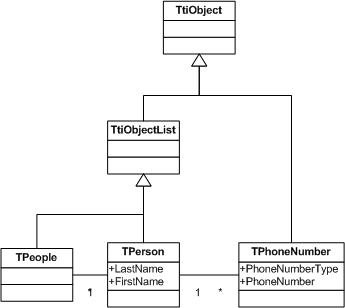tiOPF |
Free, Open Source Object Persistence Framework for Free Pascal & Delphi |
tiOPF Quick Start
Introduction
This document is a work in progress...This document will guide you through the process of building your first tiOPF application. The example will be trivial but will demonstrate the basic concepts of:
- Creating a business object model or BOM;
- Adding a user interface;
- Adding persistence to XML;
- Adding persistence to a relational database (we will use Firebird in this example);
- The pros and cons of using tiOPF's object to relational mapping (which we call AutoMap);
- How to hand craft your own classes to manage persistence (or Visitors).
The application we will build
For this example, we will build a simple address book application:- We will maintain a list of people's names;
- Each person may have one or many phone numbers;
The class diagram of the business object model we will implement is shown below:

The tiOPF provides our base classes: TtiObject and TtiObjectList. These implement GoF's Composite Pattern, which is described in more detail in the tiOPF Concepts Manual.
We shall implement three concrete classes:
- TPeople - a container list for our TPerson(s) instances;
- TPerson - a concrete person, and also a list of TPhoneNumber(s);
- TPhoneNumber - a concrete phone number.
Each TPerson shall own o..many TPhoneNumber(s)
An ER diagram of the database to persist these classes is shown below:

The three classes shall map into the two tables as follows:
| Class |
Table |
| TPeople |
No table, this is just a
container class |
| TPerson |
People |
| TPhoneNumber |
Phone_Numbers |
The trick is that TPerson is both a business object that is persisted, and a container of TPhoneNumber(s), that are also persisted.
Installing the tiOPF
If you have not already done it, download and install the tiOPF following these instructions.If you are using BDS2006 (or another version that supports code templates), you may want to copy the code templates that are installed as part of the tiOPF from here:
..\tiOPF2\Trunk\Compilers\Delphi2006\code_templates
to here
C:\Documents and Settings\[USERNAME]\Local Settings\Application Data\Borland\BDS\4.0\code_templates
(I actually check them out from Subversion directly to this directory.)
Create a directory tree
Create a directory to store your project, then add the following sub directories:- Common - for the Business Object Model, units.
- GUI - for the user interface.
- UnitTests - for the tests.
- _dcu - for object files.
- _bin - for binary files.
Create a new VCL Forms application called AdrsBook and save it to the GUI directory.
Save the main form as FMain.pas
We will get to the unit test application later.
In the Project | Options dialog, set the Output Directory to ..\_bin and the Unit output directory to ..\_dcu